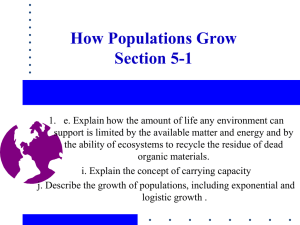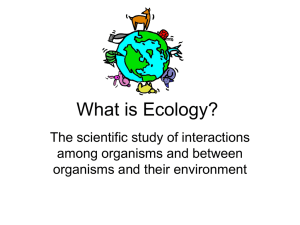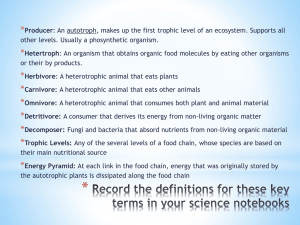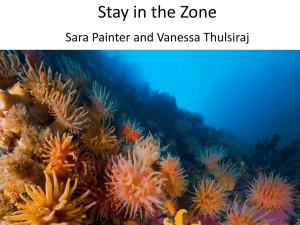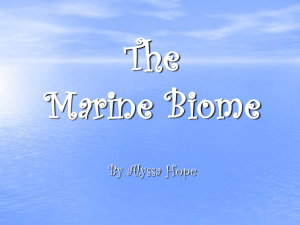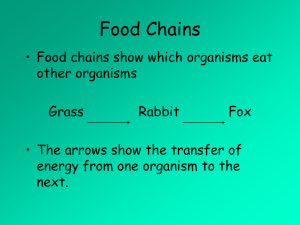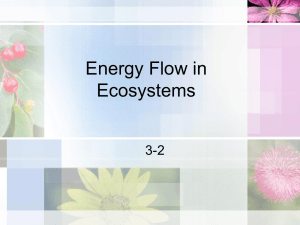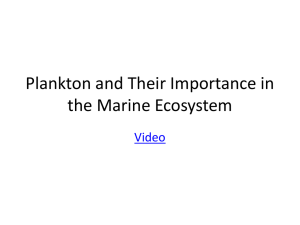Ecosystem
advertisement
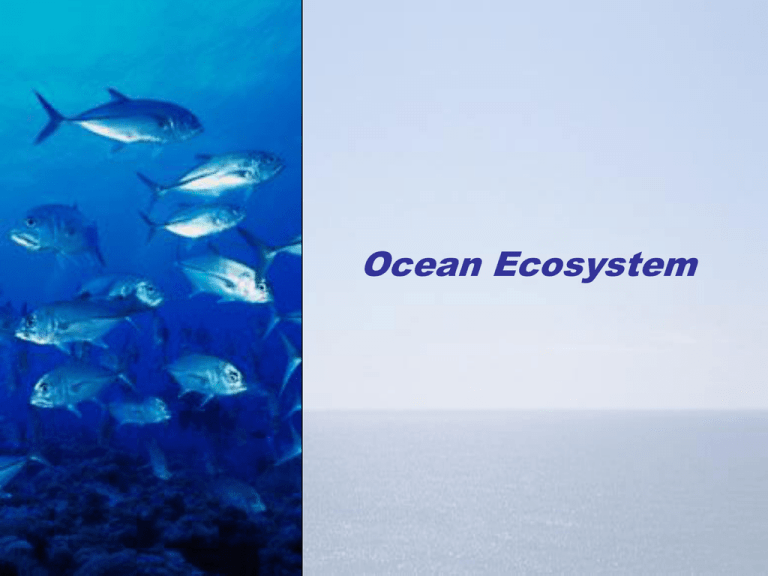
Ocean Ecosystem Goal: To understand the factors (both biotic and abiotic) that control the distribution and abundance of life in the oceans Ecosystem Review Ecosystem: “Any area of nature that includes living organisms and non-living substances that interact to produce and exchange of materials between living and non-living parts is an ecological system or ecosystem.” (E.P.Odum) Ecosystems consist of 4 components: abiotic, producers, consumers, and decomposers; 9 Ecology is the study of the interrelationships between the physical and biological aspects of the environment. It is the study of how organisms adapt to their environment and in turn alter it. Ecosystem Review Biotic Components of the Ecosystem • • • plants animals bacteria Abiotic Components of the Ecosystem • • • geological basin shape, size, & topography physical temperature, currents, pressure, light) chemical carbon, nitrogen, phosphorus, oxygen, salinity, trace metals, vitamins The Environment • The ocean water column can be separated into 2 distinct zones: the surface zone and the deep zone 1. Surface zone • extends down to about 100- 300 meters • well mixed • known as the “mixed layer” • includes the photic zone 2. Deep zone • the rest of the water column • dark and cold with much less productivity • includes the aphotic zone the pycnocline forms a physical barrier between the surface and deep zones Biozones Shelf Versus Basin Production • There are two types of organisms in any given ecosystem: autotrophs and heterotrophs autotrophs make their own food (organic matter) from inorganic nutrients (C, N, P, S, trace metals and vitamins) and either light or chemical energy, they ‘fix’ CO2 – they ‘fix’ CO2 via photosynthesis (light E) or chemosynthesis (chemical E, i.e. H2S) 6 CO2 + 12 H20 C6H12O6 + 6 H2O + 6 O2 light OR chemical E – – – autotrophs form the base of the food web (i.e. primary producers) and are ultimately responsible for all life in the world’s oceans marine examples include phytoplankton, cyanobacteria, and sulfide oxidizing bacteria (i.e. at hydrothermal vents) phytoplankton are the most abundant primary producers in the oceans Hydrothermal vents – ‘primary production’ is done by a type of extremophile, that is, a type of microorganism that can thrive under extreme env. conditions (temp > 80° C or below 90° C); these extremophiles are also chemoautotrophs – they use hydrogen and sulfur compounds as sources of energy (with or without oxygen) (chemosynthesis); Hydrothermal vents and Chemosynthetic bacteria Production (cont’d) • autotrophs vs heterotrophs (cont’d) – heterotrophs consume food (organic matter) that has already been produced they derive energy (ATP) from the breakdown of organic compounds via respiration C6H12O6 + 6 O2 6 CO2 + 6 H2O + ATP when there is no light (i.e. at night or in deeper waters) phytoplankton and cyanobacteria respire the organic compounds that they produced during photosynthesis examples of marine heterotrophs include all marine animals and most marine bacteria Photo from: Science.nasa.gov Production (cont’d) • Productivity is high in the surface waters (i.e. photic zone), due to ample sunlight for photosynthesis, and then decreases with depth (i.e. aphotic zone) Production (cont’d) • The critical depth is where total production (PT) equals total respiration (RT): PT = RT – occurs at the 1% light level Production (cont’d) • Productivity is highest in coastal waters and upwelling zones due to higher nutrient concentrations Average Global Primary Production (Chl a) March 6-13 2001 Terra MODIS NASA/GES/DISC/DAAC Biological Productivity in the Ocean Phytoplankton Blooms Bands of the dionflagellate Lingulodinium polyedrum moving onshore over the troughs of a series of internal waves Lingulodinium polyedrum: ~50 μm. Neritic; warm temperate to tropical waters; forms large blooms off of California; can be toxic. Mixed Marine Plankton Plants animals larvae adults vertebrates invertebrates carnivores and herbivores are all represented in the plankton community. NASA SeaWiFS satellite image of the large phytoplankton bloom in the Bering Sea in 1998 Dinoflagellate Gonyaulax sp. A sudden growth or bloom of th dinoflagellate, Gonyaulax, caus "red tide" . Humans have died from eating infected clams and mussels. Researchers with bongo plankton net Antarctic krill, 3.8 cm long Northern krill Trophic Interactions • To understand ocean ecology we need to know how the autotrophic and heterotropic components are related to each other (i.e. energy transfer and exchange) we examine trophic level dynamics – trophic levels describe who eats whom Trophic Interactions cont’d • The traditional view in ecology viewed these interactions linearly as a FOOD CHAIN: phytoplankton zooplankton fish • This food chain view is really too simplistic, it’s really more like a FOOD WEB with many links and complex branching between and among the various trophic levels One Ocean Drop: 1000s of planktons… Radiolaria Foraminifera Diatoms • http://en.wikipedia.org/wiki/File:Cc3s.gif • http://www.youtube.com/watch?v=kjp_jumlO3A • www.youtube.com/watch?v=eyCigZ_bsTM Jellyfish invasion Trophic Interactions cont’d • The abundance of biomass in each link is dependent on the food supply to that link Trophic Interactions cont’d • At each step in the food web, some energy is transferred to the next level and some energy is lost • This relationship can be depicted as a trophic pyramid • the shape shows the loss of energy as you move upward On average, only about 10% of the energy from one trophic level is transferred to the next trophic level Trophic Interactions cont’d • Areas of high productivity (high nutrients and ample sunlight) have less trophic levels, therefore less energy is lost and more energy is available to the next trophic level (greater fish catch!) – – – upwelling areas have 20% energy transfer efficiencies coastal areas have 15% energy transfer efficiencies open oceans globally averaged have only a 10% energy transfer efficiency UPWELLING COASTAL OPEN OCEAN Normal conditions El Nino conditions http://www.forces.si.edu/ Classification of Organisms In 1735 Linnaeus developed the taxonomic classification used in zoology. • The categories are from largest to smallest: kingdom, phylum, class, order, family, genus and species. Marine organisms can be classified by lifestyle: • Plankton are the organisms which float in the water and have no ability to propel themselves against a current. • They can be divided into phytoplankton (plants) and zooplankton (animals). • Nekton are active swimmers and include marine fish, reptiles, mammals, birds and others. • Benthos are the organisms which live on the bottom (epifauna) or within the bottom sediments (infauna). • Some organisms cross from one lifestyle to another during their life, for example being planktonic early in life and benthonic later. Crab larva – in plankton Plankton include plants (phytoplankton) and animals (zooplankton). More than 90% of marine plants are algae and most are unicellular and microscopic. • To photosynthesize (produce organic material from inorganic matter and sunlight) plants must remain within the photic zone. • Diatoms are single-celled plants enclosed in a siliceous frustrule (shell) that is shaped like a pillbox. • Dinoflagellates are single-celled plants with two whip-like tails (flagella). Zooplankton include the foraminifera & copepods Foraminifera are single-celled animals which build shells of calcium carbonate. 1 mm • Copepods are small herbivores (planteating organisms) that filter diatoms from the water. Seamount sessile fauna is dominated by suspension feeders Suspension feeding invertebrates – sponges, bryozoans, corals add structural complexity and offer a great variety of microhabitat for a diversity of species www.mcbi.org Before trawling www.mcbi.org After trawling www.mcbi.org Deep sea bottom trawling poses the greatest threat to the coral habitats It does not just take away targeted fish species There is a considerable amount of bycatch and corals are a major part of it Seamounts – underwater mountains rising >1000m from the seabed without breaking the oceans’ surface - generally of volcanic origin - often occur in chains or cluster resulting from a seafloor hot spot - 30 000-100 000 seamounts worldwide Global seamount distribution map DSCC Policy Paper : Seamounts and cold-water corals RV Atlantis DSV Alvin Classification of Organisms In 1735 Linnaeus developed the taxonomic classification used in zoology. • The categories are from largest to smallest: kingdom, phylum, class, order, family, genus and species. Three domains: http://darwin.nmsu.edu/~molb470/fall2005/projects/pan/images/PhylogeneticTreeOfLife.jpg http://ccnmtl.columbia.edu/projects/biology/lecture1/sixkingdoms.htm Classification of Organisms • Eubacteria- There are typically 40 million bacterial cells in a gram of soil and a million bacterial cells in a milliliter of fresh water; • Archaebacteria – single celled microorganisms, most are extremophiles • Protista are single-celled organisms with a nucleus (e.g. amoeba, paramecium; algae – green, red, brown) • Fungi, only few found in oceans, abundant in the intertidal zone and important in decomposition. • Metaphyta are the plants (multicellular) that grow attached to the sea floor (seaweeds). • Metazoa include all multicellular animals in the ocean. Kingdom: Protista (e.g. algae, plankton) 1 mm 100 micro-mm 100 micro-mm Kingdom Fungi • Some members of the Kingdom Fungi (in the fungal classes Ascomycetes and Basidiomycetes) are associated with algal cells of the Kingdom Protista (in the algal division Chlorophtya) and/or prokaryotic cyanobacteria of the Kingdom Monera. This complex symbiotic, mutualistic relationship is called lichen – ‘nature’s perfect marriage’; (Beatrix Potter, 1896) Yaquina Head on the Oregon coast - with darkgreenish marine lichen Verrucaria sp. Coccotrema maritimumwhite marine lichen; and Kingdom: Metaphytae Caloplaca coralloides (Monterey shores) Kingdom: Metazoa (animals) NEKTON Selective Adaptive Strategies • Speed of a fish is dependent upon body length, beat frequency, and the aspect ratio of the caudal fin. • There is a strong correlation between predation success and mode of locomotion. Atlantic menhaden Fastest fish: sailfish, marlin, bluefin tuna Selective Adaptive Strategies The morphology of fish has evolved to allow them to move through the water easily. • The fish’s body must overcome three types of drag (resistance): surface drag, form drag, and turbulent drag. • Aspect ratio is the ratio of the square of the caudal fin height to caudal fin area: AR = (Caudal Fin Height)2/Caudal Fin Area Osmoregulation by Marine and Freshwater Fish The Ocean Sciences: Ecology of the Giant Kelp Community A complex interaction among kelp, sea urchins, and sea otters controls the kelp community. • Macrocytis is a brown algae that grows up to 40m long in extensive beds on North America’s Pacific continental shelf. • Sea urchins feeding on kelp detach them from this holdfast and devastate the kelp beds. Kelp Forest Ecology The Ocean Sciences: Ecology of the Giant Kelp Community • Sea otters feed on sea urchins and control the size of their population. – Where sea otters abound, sea urchins are few, kelp beds thrive and sea otters feed mainly on fish. – Where sea otters are few, sea urchins abound and kelp bed are thin. Sea otters then mainly eat sea urchins. Blue mussels, Mytilus edulis (or M. galloprovincialis) Green mussel, Perna viridis Zebra mussels, Dreissena polymorpha http://seawifs.gsfc.nasa.gov/OCEAN_PLANET/HTML/oceanography_how_deep.html Links to Oceans: • • • • http://www.oceansatlas.org/ http://reefgis.reefbase.org/default.aspx http://www.gosic.org/ios/G3OS-maps.htm http://www.theoceanproject.org/resources/c onservation.php?category=Maps • http://earth.google.com/ocean/ Quantum Secrets Of Photosynthesis Revealed http://www.sciencedaily.com/releases/2007/04/070412131257.htm Sunlight absorbed by bacteriochlorophyll (green) within the FMO protein (gray) generates a wavelike motion of excitation energy whose quantum mechanical properties can be mapped through the use of two-dimensional electronic spectroscopy (using femtosecond temporal resolution) (Credit: Greg Engel, Lawrence Berkeley National Laboratory, Physical Biociences Division)


